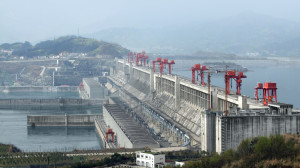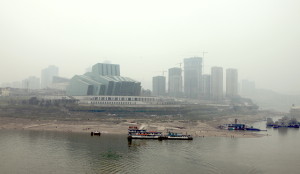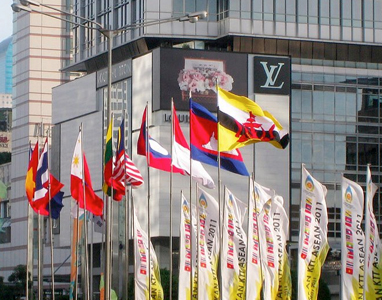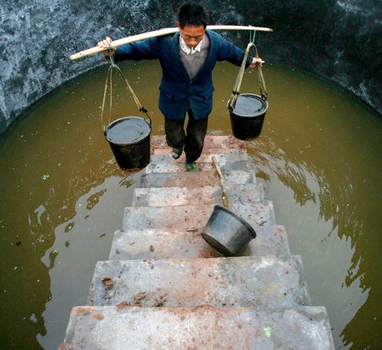The Chinese Environment: Positive Trends toward Environmental Protection
- China’s 12th Five Year Plan –Featuring Climate Change Prominently
- China’s 12th Five Year Plan –Emphasis on Renewable Energy
- China’s 12th Five Year Plan –Pushes More Effective Pollution Data Collection
- China’s 12th Five Year Plan –Looking to the Market to Help Protect China’s Environment
- Large Projected Investments in Green technologies
- Other Factors Working to Reduce Environmental Degradation in China – Green Lending
- Other Factors Working to Reduce Environmental Degradation in China – Meeting ISO Standards
- Other Factors Working to Reduce Environmental Degradation in China – NGOs
- Other Factors Working to Reduce Environmental Degradation in China – Multinationals Making a Difference
- Trends
Introduction

Environmental degradation in China has increased significantly in the last 30 years. In 2000, China’s Environmental Protection Agency found that two thirds of China’s 300 largest cities had air quality which exceeded WHO standards for acceptable levels of total suspended particulates. Additionally, China’s water is also both in short supply and highly polluted. Stresses to China’s environment will grow in the future. By 2030, it is estimated that approximately 300 million new vehicles will fill China’s roads; an additional 350 million people will move into China’s cities; and an expanding number middle class will demand better food and more consumer goods. By 2030, even with China’s rapidly developing alternative fuels capacity, it is estimated that China will need to burn almost 200 million tons more coal than in 2005 to provide sufficient heating and electricity for its new urban citizens. Indeed, overall coal-based power generation capacity is projected to triple from its 2005 rate by 2030. In 2007, the World Bank assessed that China’s combined health and non-health cost of outdoor air and water pollution to be conservatively $100 billion annually, or 5.8% of the country’s GDP, and that up to 500,000 people in China die each year from air and water pollution.
Yet, despite the magnitude of China’s environmental crisis, positive trends are emerging which will begin to slow the damage being inflicted on China’s and the world’s environment. Perhaps most importantly, Beijing is increasingly recognizing that China is placing unsustainable stress on it ecology. For the first time, China’s 12th Five Year Plan prominently features both the importance of improving energy efficiency, and of mitigating climate change. As a result, in the next five years, Beijing will invest heavily in green technologies, alternative fuels, and energy efficiency. Beijing sees these investments as one way for China to take the lead in green industries; indeed, by 2015, for example, China is projected to have the world’s largest installed capacity of alternative fuels.
This trend toward greater environmental protection is also being driven by a growing emphasis on green lending within China’s banking sector, and by China’s need to comply to international environmental standards such as the ISO 14001 in order to compete in international markets. Domestic and international NGOs are also gradually raising environmental awareness in a whole range of areas. Multinational corporations, too, are playing their part, progressively insisting that their Chinese factories meet local environmental regulations, and introducing into China environmentally friendly technologies and practices.
China’s 12th Five Year Plan –Featuring Climate Change Prominently
 For the first time, China’s 12th Five Year Plan highlights climate change and energy efficiency prominently. The plan sets a GDP growth target of 7%, which would be a significant slowdown from the average 11.2% rate of growth reached between 2006 and 2010. The 12th Five Year Plan and subsequent commitments also adopt as domestic, binding law the voluntary climate pledges China made at Copenhagen in 2009. Specifically, by 2015, China plans to reduce its carbon intensity by between 40% and 45% from 2005 levels, to increase its forest cover by 12.5 million hectares and its forest stock volume by 600 million m³. As of 2015, these same goals remain unchanged, and China has pushed them another five years into the future. The country now hopes to realize these reductions by 2020. Measuring China’s progress towards these goals remains inaccurate because the nation has not released many reliable and updated figures on carbon intensity to the public. The figures remain ambitious: by 2020 China aims for an energy distribution of 350 GW in hydropower, 200 GW in wind power, and 100 GW in solar power.
For the first time, China’s 12th Five Year Plan highlights climate change and energy efficiency prominently. The plan sets a GDP growth target of 7%, which would be a significant slowdown from the average 11.2% rate of growth reached between 2006 and 2010. The 12th Five Year Plan and subsequent commitments also adopt as domestic, binding law the voluntary climate pledges China made at Copenhagen in 2009. Specifically, by 2015, China plans to reduce its carbon intensity by between 40% and 45% from 2005 levels, to increase its forest cover by 12.5 million hectares and its forest stock volume by 600 million m³. As of 2015, these same goals remain unchanged, and China has pushed them another five years into the future. The country now hopes to realize these reductions by 2020. Measuring China’s progress towards these goals remains inaccurate because the nation has not released many reliable and updated figures on carbon intensity to the public. The figures remain ambitious: by 2020 China aims for an energy distribution of 350 GW in hydropower, 200 GW in wind power, and 100 GW in solar power.
The five year plan sets several separate targets for 2015, including: a 16% reduction in energy intensity; a 17% reduction in CO2 emissions per unit of GDP; an 8% reduction in demand for both chemical oxygen and sulfur dioxide; a 10% reduction in both ammonia nitrogen and nitrogen oxides. The plan also highlights the need to improve sewage and sludge treatment, and to better the rates of desulfurization and de-nitrification. It also seeks to protect the living environment with policies to reduce rural pollution from agriculture, to expand nature reserve development and biodiversity conservation, and to extend waste management infrastructure. Beijing is also planning to upgrade subway and light rail in cities that already have urban transit systems, as well as to construct new systems in at least nine other cities. It will also build 35,000 miles of high speed railway with the ultimate goal of connecting every Chinese city of 500,000 or more people. China may also soon unveil plans to create 10 million electric car charging spots by 2020.
Looking at the layout of the 12th Five Year Plan, decisions 52 through 54 of the 12th FYP are especially promising. The 52nd decision puts forward a commitment to establishing national parks and outlines a more flexible plan for local governments. Municipal officials in environmentally damaged areas who were once expected to meet certain GDP targets will no longer be held accountable to those numbers. Instead, their decisions and implemented policies will be closely monitored to assure that they are not furthering the environmental damage in their respective regions. The 54th decision works together with the 52nd, laying out the groundwork for a system where all environmentally-related developments must be licensed. With the added scrutiny and pressure to meet economic goals removed, it will be much more difficult for government officials to find legitimate reasons supporting preferential treatment for companies damaging local rivers and farms. Decision 53 acts as a capstone to this policy outline, reflecting China’s recognition that the current environmental situation has resulted from years of damaging habits and forming a national plan to rehabilitate damaged farmland.
China’s 12th Five Year Plan –Emphasis on Renewable Energy
The 12th Five Year Plan also seeks to have renewable energy account for 11.4% of China’s power consumption by 2015. China plans to increase wind power by 70 gigawatts. With regard to nuclear power, China projects installing 40 additional gigawatts of safe capacity by 2015, though after the disaster at Fukushima in Japan, China has also vowed to review and strengthen the safety of all its nuclear power as part of its expansion strategy. China anticipates increasing its hydropower to approximately 380,000 MW by 2020 and expects to have solar capacity of between 10 GW to 30 GW by 2020. Indeed, seven of the planet’s top 10 solar panel makers are now Chinese. At the end of 2014, the China Electricity Council reported that renewable energy sources had increased their share by 19%, while fossil fuel usage declined 0.7%. Energy capacities also increased significantly: China’s non-fossil fuel energy capacity rose by 55.8 GW to 444GW, with solar, hydro, and wind power rising by 10.6 GW, 22 GW, and 23.2 GW respectively. These changes surpass those outlined in China’s 12th Five Year Plan, and put it on track to meet 2020 targets. Should it meet them, China will have the most installed wind, nuclear, and hydro-power in the world, and will have one of the largest solar capacities.
As a whole, China’s renewable energy sector has expanded dramatically over the last few years. From 2009 to 2013, the total production of renewable energy sources expanded nearly 13.3% annually, and is expected to remain fairly high at 11.8% per year in the five years ending 2018. National investment in green energy has also increased quite healthily, with USD $87.5 billion invested in total during 2014, up 36% from 2013 and comprising just over 32% of global investment in the sector. All of these positive changes have catapulted China into the number one spot in many renewable- and green energy-related production indices, and have made the nation the world leader in renewable power development. In the 2015 report from the Renewable Energy Policy Network for the 21st Century, known as REN21, China took the top spot in 11 of 26 categories: greatest investment in 2014 in renewable power and fuels, hydropower capacity, solar photovoltaic and water heating capacity, wind power capacity, and greatest generation by volume of renewable power (both including and excluding hydropower), total hydropower capacity, total wind power capacity, total solar water heating capacity, and total geothermal heat capacity. Wind power continues to rise in China, with Asia as the dominant market for the past seven years. As of 2014, the total capacity of wind power in Asia has surpassed that of Europe, in large part because of China’s extensive investment in the field. Indeed, the whole renewables industry has momentum that will carry China forward into future years and determine goals established in further Five Year Plans.
China’s 12th Five Year Plan –Pushes More Effective Pollution Data Collection
Of key importance to its environmental efforts is China’s intention to implement comprehensive data collection and monitoring systems, soon allowing it to follow a more data-driven approach to environmental policy. Yet, it is not clear how much of that data will ultimately be made available to either the public or the wider world. China’s political vulnerability because of environmental pollution is still a serious concern within a Chinese leadership that fears environmentally triggered “mass incidents” (a euphemism for protests or social unrest) and the resulting social instability. There is also concern that foreigners will use environmental data to interfere in China’s internal affairs.
For example, recent air quality monitoring by the US embassies in Beijing, and most recently Shanghai, has led to controversy as US reading contradict Chinese official data. Increasing numbers of Chinese citizens, along with many in the expat community in China, are turning to US environmental data. In 2011, for instance, Beijing health authorities insisted that air quality was perfectly safe 80% of the time while US statistics rated the air quality is good for about 4% of the time. The discrepancy in readings results from the fact that the US Embassy monitors small air particles known as PM 2.5 which Beijing authorities have neglected to include in their data. Chinese authorities have work to quell increasing controversy by agreeing to measure the PM 2.5 particles as of 2015. They have also called into question the accuracy of the US readings. According to Wikileaks, in 2009, Chinese officials went as far as to request that the US Embassy stop tweeting its air pollution data because it said the conflicting data was “confusing” and could cause “social consequences”. As of May 2012, the US Consulate in Shanghai has also begun issuing pollution statistics. The US Consulate alerted Shanghai officials in advance that it would be publishing pollution data. In its tweets, the US Consulate emphasizes that the pollution results are derived from monitoring equipment solely based at the US Consulate, and do not necessarily reflect the air pollution quality of the entire city. Again, US data conflicted with the official Shanghai statistics, with the US consulate finding the air quality as unhealthy, where the Chinese data finds the air quality good. By June 2012, the Shanghai Environmental Protection Bureau will also release air quality data including PM 2.5 particulates.
Like the divergent air quality statistics, reports on provincial emissions often differ significantly from on-site data. Some suggest that this may be the result of China’s national carbon emission reduction targets, because businesses find it easier to meet their carbon goals if they overestimate them at the outset. To remedy this inconsistency, the Chinese Academy of Sciences has begun a year-long study to identify the largest carbon emission culprits and their numerical contribution to China’s carbon outlay.
Studies on the pollutants affecting China’s soil quality also remain scarce. Some of the more recent statistics indicate a large, but largely ignored problem. Pollution in 16% of all Chinese soil exceeded standards, and 19.4% of all arable land contained heavy metals, also above acceptable limits. Enough productive land has been affected that China may be risking a loss of food security and self-sufficiency should the decline in land quality continue. The 12th Five Year Plan does push for improved data collection, but China still has areas in the environmental sector that need improved data collection before resources are destroyed beyond repair.
China’s 12th Five Year Plan –Looking to the Market to Help Protect China’s Environment
In addition to new pollution targets and better data gathering, China 12th Five Year Plan articulates market-driven solutions to reduce pollution domestically, including: offering financial incentives to enterprises engaged in sewage treatment, sludge treatment, desulfurization, de-nitrification and waste disposal; strengthening the pollution charging system so that high-pollution production faces higher costs; encouraging lending to green projects; and increasing the portion of green products on government procurement lists. Beijing is also considering evaluating party member performance on pollution mitigation as well as GDP growth targets. The plan also proposes an environment tax in order to deter pollution, promote clean technology and create funding for environmental clean-up. It is likely that the tax will be first introduced in China’s wealthier provinces, and then rolled out nationally. Cap-and-trade carbon pilots on the national scale are also being deliberated, as is an expansion of the 11th Five Year Plan “1000 Enterprises Program” to “10,000 Enterprises Program.” Regional carbon trading programs have already officially begun pilot testing in several provinces, with the ultimate goal of creating a unified carbon cap-and-trade system sometime around 2017. Going estimates place the size of this potential market at around RMB 100 billion by 2020.
In 2005, it was determined that the energy consumption of the top 1000 Energy Consuming Enterprises accounted for 33% of national and 47% of the dead industrial energy usage in 2004. Under the program, 2010 energy consumption targets were determined for each enterprise. High energy consumption enterprises include those competing in the iron and steel, petroleum and petrochemicals, chemicals, electric power generation, non-ferrous metals, coal mining, construction materials, textiles, and pulp and paper industries. While detailed information on program results is difficult to attain due to confidentiality, a 2010 study by Lynn Price, Xuejun Wang and Jiang Yun indicated that the Top 1000 Enterprises Plan was tracking positively to reach its goal of saving 100 metric tons carbon equivalent (Mtce) in 2010, could even surpass the figure by as much as 48 Mtce. When calculated in terms of reduced CO2 emissions, the effect of the Top-1000 program is enormous. Meeting the 2010 100 Mtce savings target will result in energy-related CO2 emissions reductions of 300 MtCO2, an amount equivalent to the 2005 annual emissions of Poland.
Indeed, improving energy efficiency is key to China’s new, “scientific outlook” on development. The scientific outlook most immediately focuses on technological solutions, notably through improved efficiency as the principle short term way to conserve resources. The program also promotes the idea of a “circular economy” where China actively reduces, reuses and recycles. It is by efficiency gains, the pursuit of the circular economy, the employment of alternative energies, and the embracing of new green technologies that Beijing believes that it can significantly grow GDP while ensuring sound ecological conditions.
Large Projected Investments in Green technologies
If all the measures proposed in the 12th five-year plan are implemented, China will be creating a huge market for clean technologies, with the potential to exceed $1 trillion. Beijing will be investing heavily in the sector. During the 12th five-year planning period, Beijing’s green sectors investments are expected to reach $468 billion, up from $211 billion over the previous plan. The bulk of the investment is slated for waste recycling and reutilization, green technologies such as alternative fuel vehicles, and renewable energy. This investment will drive projected annual growth in China’s environmental protection industries to an average of between 15% and 20% through 2020. World Watch Institute, a research institute devoted to the analysis of global environmental concerns, expects that China will create as many as 4.5 million new green jobs during that period.
With these and other investments, in the future, China hopes to lead the world in green technology, leapfrogging the developed world’s carbon-based economies. The transition costs to a less carbon-dependent economy will be less for China than for advanced economies, because it is not locked into a high-carbon model to the same degree. Also, green technology levels in the developed and developing worlds are on par, so that China also does not have to play catch-up to be competitive in the sector. Indeed, many in the international environmental movement have expressed hope that China may ultimately lead in climate change initiatives, particularly given its large and growing investments in the sector.
Other Factors Working to Reduce Environmental Degradation in China – Green Lending
In February 2012 the China Banking Regulatory Commission (CBRC), China’s top banking regulator, issued the Green Credit Guidelines to help facilitate China’s transition to a more environmentally friendly development model. The guidelines apply to domestic policy banks, commercial banks, rural cooperation banks and rural credit cooperatives, as well as village banks, loan companies, rural funding cooperatives and non-banking financial institutions. . The guidelines encourage lenders to reduce loans to industries with high levels of energy consumption and high levels of pollution, and to strengthen financial support for green industries and projects. Specifically, the guidelines require the financial institutions’ Board of Directors or Council to take charge of establishing a “green credit development strategy”, as well as to approve green credit loans, issue regular green credit reports, and supervise the institution’s green credit performance. Senior management will be responsible for reporting annually to the Board of Directors and regulators about the progress of green credit practices. Additionally, banks will also be required to maintain a list of high-polluting clients, and urge these clients to take pollution mitigating measures. In the future, banks will also be expected to do more thorough environmental due diligence before lending, and restrict credit to highly polluting clients.
Even if credit has been granted, disbursement of the loan proceeds can be suspended or terminated if the client begins to engage in environmentally damaging practices. Post-lending, banks are required to report to regulators any behaviors by its borrowers which are resulting in environmental damage. For overseas projects, financial institutions must ensure their financing is for projects complying with local environmental regulation. Banks are also required to conduct internal audits of their green credit practices regularly; every two years, a comprehensive evaluation of its green credit practices are to be submitted to the CBRC. The CBRC is to conduct off-site and on-site inspections to ensure that financial institutions comply with its Green Credit Guidelines.
These regulations are designed to further develop what was already a growing trend in green lending in China. By end of 2011, China’s six largest banks – China Development Bank, Industrial and Commercial Bank of China, Agricultural Bank of China, Bank of China, China Construction Bank, and Bank of Communications – had a total of $301.75 billion in green credit lending. In particular, in 2011, China Development Bank lent $104 billion to support environmental protection, energy saving and emissions reduction projects, accounting for 12.7% of the bank’s total outstanding loans. Even before the 2012 guidelines, green lending in China was growing because of rising demand by customers, and because government support for green projects has meant that many green loans have lower non-performance ratios. Ultimately, the future success of the guidelines will be dependent on the banking industry’s ability to collect accurate environmental data on its customers. Certainly, the government’s 12th Five-Year Plan indicates a greater commitment to environmental data gathering. Again, it still remains to be seen whether Beijing will then allow this information to be more widely circulated.
Other Factors Working to Reduce Environmental Degradation in China – Meeting ISO Standards
 China’s participation in standardization laws are also helping to drive pro-environmental business practices. ISO, an international organization headquartered in Geneva, issues two kinds of specification standards to which China strives to comply: those which facilitate commerce by normalizing product standards and those which standardize procedures. The IS0 14001 incorporates environmental policy into its framework by creating a standardization of management practices and implementation of environmental procedures. Since 2006, China has led the world in ISO 14001 certificate registrations. China’s ISO compliance efforts are driven by the fact that many of the markets into which China exports now request ISO 14001 observance.
China’s participation in standardization laws are also helping to drive pro-environmental business practices. ISO, an international organization headquartered in Geneva, issues two kinds of specification standards to which China strives to comply: those which facilitate commerce by normalizing product standards and those which standardize procedures. The IS0 14001 incorporates environmental policy into its framework by creating a standardization of management practices and implementation of environmental procedures. Since 2006, China has led the world in ISO 14001 certificate registrations. China’s ISO compliance efforts are driven by the fact that many of the markets into which China exports now request ISO 14001 observance.
Other Factors Working to Reduce Environmental Degradation in China – NGOs
Domestic and international NGOs are also becoming increasingly important to China’s environmental activism. The Academy for Green Culture, now called Friends of Nature, was the first environmental NGO formally registered in China in 1994. Since then, several hundred international and domestic NGOs engage in nature conservation, species protection, environmental education, policy advocacy, data collection, legal advocacy, environmental information exchange, wasteland reclamation and organic farming. Indeed, leaders of three Chinese NGOs were appointed as environmental advisers to the Beijing 2008 Olympic Bid Committee and were instrumental in helping China win its bid. These NGOs work both at a community and a national level. Examples of NGOs active in China include Green River, Global Village of Beijing, Institute of Environment and Development, the World Wildlife Fund, Green Earth Volunteers, Green-Web, the Natural Resources Defense Council, Greener Beijing, and the Center for Legal Assistance to Pollution Victims.
Despite their growing presence, NGOs face real challenges when working in China. NGOs often lack any real influence, particularly when faced with entrenched business interests. Domestic NGOs are often challenged by fund raising difficulties. On many occasions, new NGOs have been refused registration, thus denying them the benefits of NGO status. The government also closely scrutinizes the work of these NGOs in order to prevent environmentalism from evolving into a push for broader political reform. In general, domestic NGOs are reticent to criticize the central government publicly, and work hard instead to engage in cooperative relationships with local officials.
Other Factors Working to Reduce Environmental Degradation in China – Multinationals Making a Difference
Multinationals are also beginning to positively impact environmental protectionism in China. Given that China is often their factory, and given the growing environmental activism within China at the governmental, NGO, academic and social levels, multinational corporations are increasingly under pressure to ensure that their production, and the production of their suppliers, in is in compliance with local environmental standards. For example, in August 2011, Apple received bad press for ignoring its suppliers’ outstanding public pollution violations which had been brought to its attention by a consortium of five Chinese environmental NGOs. Within a month, Apple was working with its suppliers and the NGOs to improve environmental performance.
Multinationals are also increasing taking initiative in helping their Chinese suppliers use energy, water and materials more efficiently, and reduce emissions where possible. Shell China, for instance, one of the largest multinational companies operating in China, has been introducing better environmental practices and technologies. In 2009, in the Changbei Gas Field, where it works jointly with PetroChina, Shell increased gas production by 11% while decreasing energy intensity, resulting in annual savings of around 2500 tons of standard coal – enough to provide sufficient power to support 10,000 urban Chinese families for three and a half years. The project also reduced the volume of its wastewater by 70%. These environmental practices are good business as they improve profitability. Yet, they are also introducing methods and technologies that are then absorbed more broadly. Multinational investors also drive environmental practice in China. Worried about environmental liability, they encourage multinationals to implement stricter environmental practices.
Trends
 Despite the many factors which will continue to perpetuate environmental degradation in China over the coming decades, and the magnitude of China’s environmental challenge, China’s environmental trends are not all grim. Indeed, many developments indicate that China will make increasing progress in the field of environmental protection.
Despite the many factors which will continue to perpetuate environmental degradation in China over the coming decades, and the magnitude of China’s environmental challenge, China’s environmental trends are not all grim. Indeed, many developments indicate that China will make increasing progress in the field of environmental protection.
One of the most important of these developments is the growing emphasis Beijing is placing on environmental protection. Indeed, not only is Beijing beginning to articulate a well thought out and increasingly detailed plan as to how China can begin to protect and restore its bio-capacity, but it is also backing that plan with an unprecedented level of short-term investment. This investment will soon allow China to take leading positions in many environmental sectors. For instance, by 2015, China will have more installed alternative fuel capacity than any other country.
This investment will create huge opportunities in China’s green technologies market. Investing heavily in green technologies may enable China to gain an advantage over developed countries with a heavy reliance on their carbon-intensive economies. For instance, China now has the largest solar water heater market in the world. Approximately 95% of patents for core solar water heating parts are owned by Chinese companies. These patents allow heaters to function even under grey skies and at temperatures well below freezing. It is estimated that at least 30 million Chinese households now heat their water with solar panels.
Indeed, leading the development and implementation of green technology is one of the ways China is creating the competitive edge it needs to remain an economic powerhouse in the future, especially as its rapidly aging and shrinking workforce means that it will not be able to indefinitely compete just on the basis of cheap, plentiful labor. As the impact of global warming is increasingly felt, and as growing fossil fuel demand continues to put upward pressure on fuel prices, demand for green technologies will rise. China will position itself to profit from these opportunities by first introducing green technologies at home before aggressively seeking to export them to foreign markets.
China will begin to lead the way in green architecture and urban development as 70% of its population settles into cities by 2030. It will increasingly introduce technologies which will avoid high electricity consumption in buildings. Specifically, we will see China install more energy-efficient lighting, appliances, heating, ventilation and air-conditioning systems, and better insulation in walls, windows and roofs. Similarly, it will also prioritize retrofitting its existing building stock with energy-saving features.
 China will also invest in the development of alternatives to internal combustion engine (ICE) transportation. This can already be seen in its growing commitment to the construction of rail and mass transit systems. China can also be expected to increasingly reduce emissions and increase fuel efficiency in the ICE cars that do reach its streets. It will also continue to invest heavily in alternatives to ICE cars. Specifically, China plans to push the full range of advanced battery technology for electric vehicles. Indeed, by exploiting its current pool of low-cost labor, along with its fast-growing domestic car market, its proven success in rechargeable battery technology, and its substantial investments in R&D, China has the potential to emerge as a global leader in electric vehicle technology in the coming decades. Indeed, its plans to create 10 million electric car charging parking spots by 2020 suggests that it the pursuit of affordable, high-performance electric vehicles will continue to be a priority. Currently, China has 16,000 AC charging spots in operation.
China will also invest in the development of alternatives to internal combustion engine (ICE) transportation. This can already be seen in its growing commitment to the construction of rail and mass transit systems. China can also be expected to increasingly reduce emissions and increase fuel efficiency in the ICE cars that do reach its streets. It will also continue to invest heavily in alternatives to ICE cars. Specifically, China plans to push the full range of advanced battery technology for electric vehicles. Indeed, by exploiting its current pool of low-cost labor, along with its fast-growing domestic car market, its proven success in rechargeable battery technology, and its substantial investments in R&D, China has the potential to emerge as a global leader in electric vehicle technology in the coming decades. Indeed, its plans to create 10 million electric car charging parking spots by 2020 suggests that it the pursuit of affordable, high-performance electric vehicles will continue to be a priority. Currently, China has 16,000 AC charging spots in operation.
Despite China’s growing commitment to alternative fuels, its use of coal will still rise significantly in the future. Increasingly, China will work to offset its carbon emissions by investing in technology that sequesters carbon emissions for next-generation coal plants. Indeed, China wants its clean energy sectors and it clean energy technology to become 15% of its economy by 2020.
Also of note is China’s growing nuclear program, which has exhibited consistently high rates of growth over the last 15 years. Consumption in the sector is expected to increase by 15.4% for the next five years ending 2020, while renewable energy is projected to grow around 7.5%—though this is likely due to the high level of development that China has already achieved in its fairly mature renewable energy sector (which accounts for 9% of energy production in the nation, compared to the 1% share occupied by nuclear energy).
Furthermore, China currently produces a lot of industrial municipal waste that it does not recycle or properly manage. China will increasingly rectify this by employing technologies that will allow it to convert its waste into useful material. For instance, there’ll be a growing trend toward coal-bed methane recovery and recovery of blast furnace slag resulting from steel production. It will also seek to burn more of its municipal waste to generate electricity, instead of sending it all directly to landfill.
Green lending, ISO compliance, the influence of domestic and international NGOs and multinationals will also continue to drive positive environmental behavior in China. It can be expected that China will also be inviting more foreign investment in the green technologies sectors.
All that said, many of China’s dominant economic and political incentives have not changed. 129 million Chinese citizens still live on less than $1.25 a day, and 400 million earn $2 a day. China’s population will continue to grow through at least 2030, and inequality in China has increased significantly both within the population, between rural and urban residents, and between different regions within the country. Those Chinese moving into the middle classes will demand a better diet and consumer goods. China’s government will thus remain under enormous pressure to improve the standard of living of its people and to reduce inequality nationally. Proponents of low carbon future for China thus face significant opposition by others who suggest that China should focus on unrestrained development until more of its population has reached a modest but dignified standard of living. China’s 11th Five Year Plan also advocated a slower, more balanced GDP growth, yet China’s GDP growth exceeded 11% during the period. Local governments, in particular, have many incentives to keep to business as usual.
Still, within the international climate community, there is some hope that China may come to take a leadership role in climate change mitigation. They note that China has not stepped back from its 2009 voluntary Copenhagen commitments; instead it has translated them into binding domestic law. They also note China’s opportunity to leapfrog the carbon-based infrastructure installed in developed countries, partly because of its history of radical experimentation, but also because of the greater ability of its authoritarian government to dictate far-reaching environmental policy. China’s obvious desire to profit from the rapidly growing green technology sectors is, therefore, potentially good news for everyone.
Ultimately, Chinese leaders have an opportunity to follow a path of development that diverges from a Euro-American capitalist model that is no longer accepted as indefinitely sustainable; in the long run, the world does not have the bio-capacity to support billions of new people consuming like Americans and Europeans. The Chinese leaders seem to increasingly acknowledge this. In 2008, for instance, Ambassador Yu Qingtai noted that while he could not accept that as a Chinese, he was only entitled to one quarter of what western developed nations have enjoyed, he also recognized that it would be a nightmare for China if its 1.3 billion people had the same per capita emissions as the Americans. That representatives of the Chinese government are beginning to articulate that high Chinese per capita emissions would be a nightmare for the Chinese themselves is also grounds for optimism about the possibility of improved global environmental protection. The outlook continues to be positive. In November 2014, China announced plans to halt emissions increases by 2030. With these national efforts China will certainly see large changes, and perhaps the birth of entirely new markets, in the coming years.












